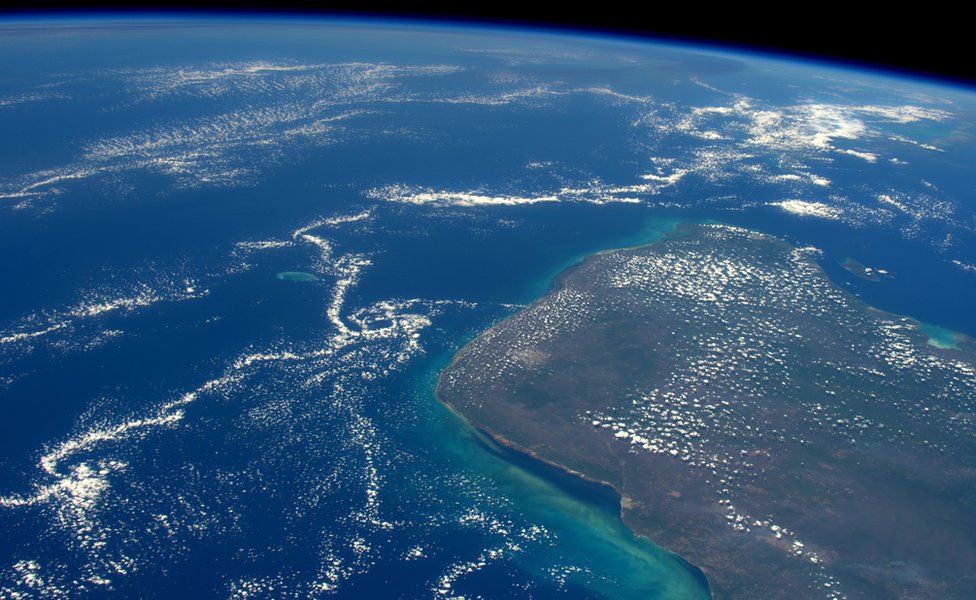Dinosaur crater's clue to origin of life
- Published

The crater is buried partly offshore and partly onshore, under Mexico's Yucatan Peninsula
The crater made by the asteroid that killed off the dinosaurs is revealing clues to the origins of life on Earth.
Scientists have drilled into the 200km-wide Chicxulub crater now buried under the Gulf of Mexico.
They say its rocks show evidence of having been home to a large "hydrothermal system", where hot fluids flowed through cracks and fissures.
Similar systems, generated by impacts on the early Earth, could have helped kickstart the first lifeforms.
The hydrothermal system at Chicxulub may have been active for two million years or more, the scientists say.
Dr David Kring, from the Lunar and Planetary Institute in Houston, is one of the researchers who discovered and reported the crater's location.
"The impact generated a very large subsurface hydrothermal system," he told BBC News.
"That's exciting because we are using Chicxulub as a proxy for other, large impact events very early in Earth's history when we think these kinds of systems might have been crucibles for pre-biotic chemistry and the habitats for the evolution of the earliest life on our planet."
About 829m of Chicxulub core material was drilled between May and June 2016. Since then, team-members have been hard at work examining rocks from the crater which was punched in the crust by a 15km-wide space object some 66 million years ago.
The drilling project targeted an area called the peak ring, which contains the rocks that moved the greatest distance in the impact.
A sample of the core drilled from the Chicxulub peak ring; about 829m of core material was recovered
At a briefing here at the Lunar and Planetary Science Conference (LPSC) in Texas, Prof Sonia Tikoo, who studies palaeomagnetism, said the cores had given scientists a lower bound for how long this hydrothermal system lasted.
The direction of Earth's magnetic field flips every few hundred thousand years. When the Chicxulub extinction event occurred it had the reverse polarity to today.
"One thing that was very intriguing was that there were several samples in the breccia melt sequence that had what's now the normal polarity - the same direction as what we have today," the Rutgers University, New Jersey, scientist said.
"Three hundred thousand years [after the impact] the Earth's magnetic field crosses over and assumes the 'normal' polarity - it has the opposite direction [to that which existed at the time of the impact]. These rocks must have acquired their magnetisation during one of these normal polarity times that came later. Since the first of these happened 300,000 years later - that provides a lower bound constraint for the hydrothermal system, telling us how long hot fluids were going through the crater."
The whole system may at first have been too hot for even the most heat-tolerant microorganisms. However, as time went on, the peak ring would have cooled down, allowing tiny lifeforms to exploit the chemicals dissolved in the hot fluids for fuel.
Chicxulub Crater - The impact that changed life on Earth
The outer rim (white arc) of the crater lies under the Yucatan Peninsula itself, but the inner peak ring is best accessed offshore
A 15km-wide object dug a hole in the crust 100km across and 30km deep
This bowl then collapsed, leaving a crater 200km across and a few km deep
Its central zone rebounded and relaxed, producing an inner "peak ring"
Today, much of the crater is offshore, buried under 600m of sediments
On land, it is covered by limestone deposits, but its outline is visible
It is evident in an arc of famous sinkholes referred to as cenotes
Mexico's famous sinkholes (cenotes) have formed in weakened limestone overlying the crater
"With regard to the hydrothermal system, we've been able to deduce the mineralogy that the hot water fluids produced," said Dr Kring.
"We're starting to track, in time, the thermal evolution: how hot the waters got and we've been able to watch how they cool down.
"Eventually, they get cool enough to support thermophilic and hyperthermophilic organisms - the same type of biota that live at volcanic hot springs. These would have lived within the fractures and the veins of this subsurface impact crater.
"We don't know how diverse this population will be. Is it two species that persists for millions of years? Or will we see an explosion of life so that we suddenly see 15 or 30 or 50 species?"
The asteroid impact killed off 75% of species on Earth, including the dinosaurs.
Debris thrown into the atmosphere probably saw the skies darken and the global climate cool. It may also have triggered raging wildfires. But why this environmental cataclysm killed off some groups such as the dinosaurs, while allowing birds and mammals, for example, to survive remains unclear.
"The differential survival of animals on the planet - we don't know why birds survived and why turtles and some types of reptiles survived," pondered Dr Kring. "But based on this borehole, we are going to get some limits on important parameters like energy, like trajectory - and all of that is data that will carry us towards those answers."
The project to drill into Chicxulub Crater was conducted by the European Consortium for Ocean Research Drilling (ECORD) as part of the International Ocean Discovery Program (IODP). The expedition was also supported by the International Continental Scientific Drilling Program (ICDP).
Follow Paul on Twitter., external